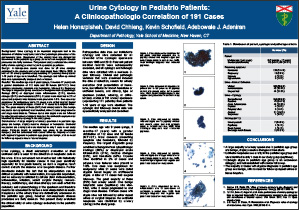Urine Cytology in Pediatric Patients: A Clinicopathologic Correlation of 191 Cases
Helen Honarpisheh, David Chhieng, Kevin Schofield, Adebowale J. Adeniran
Department of Pathology, Yale School of Medicine, New Haven, CT, USA
ABSTRACT
Background: Urine cytology is an important diagnostic tool in the detection of bladder neoplasms and other pathologic processes of the genitourinary tract. Neoplasms of the urinary tract are distinctively uncommon in the pediatric age group, however non-neoplastic disease processes are fairly common. This present study evaluated the clinical utility of urine cytology exclusively in the pediatric population.
Design: A retrospective search was done for all urine samples examined in the cytology unit of our department from 1995 to 2010. A total of 191 urinary specimens (representing 171 patients) from patients 1-18 years of age were identified. The cytologic and follow-up clinical data was systematically analyzed and correlated.
Results: The median age was 9 years (range, 3 months-17 years) with a gender distribution of 112 male and 59 female (M:F=2:1). Most common presenting symptom was hematuria, followed by frequency. The largest diagnostic group consisted of benign/normal cytopathologic findings (88%) or displayed acute inflammation (21%), reactive changes (24%), and hematuria (40%). Crystals were identified in 2% of cases and polyoma virus features were present in 1.6%. One case was suspicious for malignancy while 21 cases were called atypical based largely on architectural atypia. A total of 11 cases had surgical follow-up. The great majority of these (55%) had urinary calculi. One benign neoplastic case (papilloma) was identified, while 2 cases progressed to end stage renal disease. Thirteen cases with atypia were not followed by either repeat urines or surgical biopsies. No urothelial neoplasm was identified by urinary cytology in the study group.
Conclusions: A large majority of urinary specimens in pediatric age group are benign, display reactive changes or hematuria. Urothelial neoplasms are a rarity and were identified in only 1 case in our study group. Cytologic atypia in pediatric age group is an uncommon category, and not associated with cancer follow-up. Majority of cases with atypical diagnosis in pediatric age group are benign, with no need for follow-up repeat urines or tissue biopsies.
©2013 Yale Department of Pathology. All rights reserved.
Any redistribution or reproduction of part or all of the contents in any form is prohibited. You may not, except with express written permission of the author or the Department of Pathology, distribute or commercially exploit the content, nor may you transmit it or store it in any other website or other form of electronic retrieval system, including use for educational purposes.
